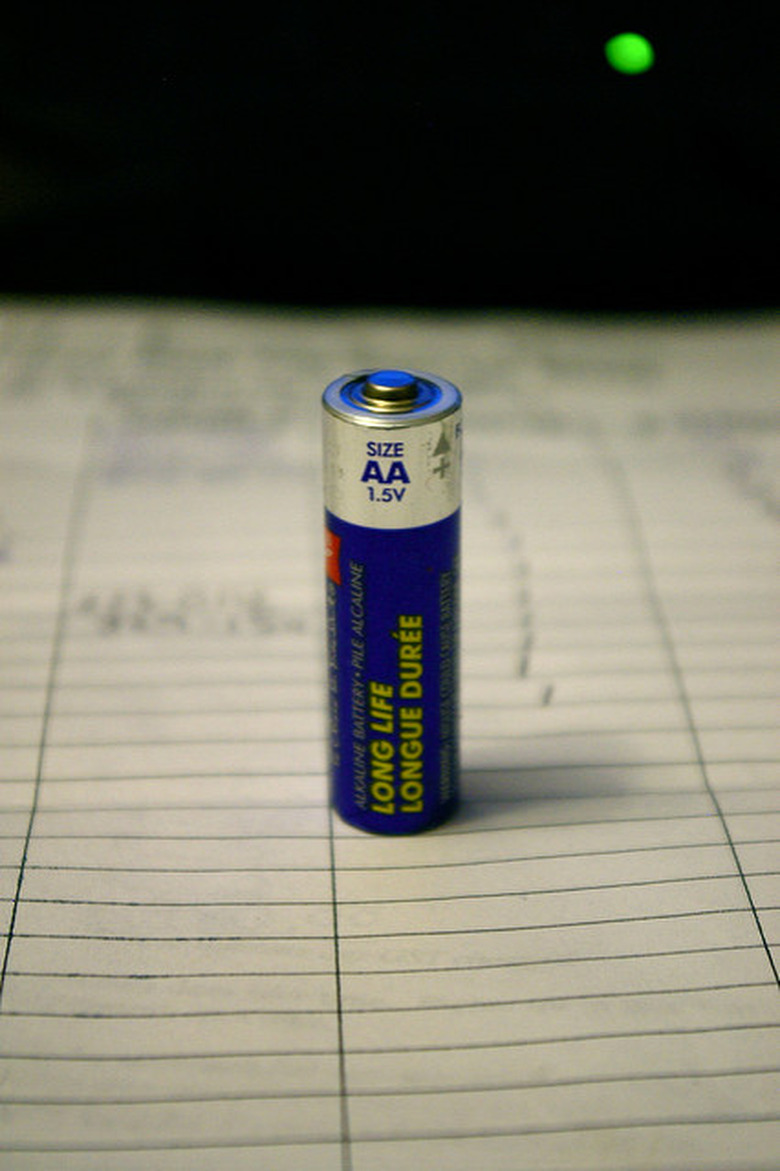How To Test Dry Cell Batteries
We may receive a commission on purchases made from links.
Dry cell batteries consist of a sealed chamber containing an anode, cathode and paste-like electrolyte. AAA, AA, C and D-cell batteries are all examples of dry cells, as are the 9-volt batteries you use in smoke alarms. All of these are designed to function at a particular voltage, but simply measuring the voltage with a multimeter won't tell you whether or not the battery is good. You need to include a load in the testing circuit to get an accurate reading. Before you reach for the meter, you might try a couple of simple tricks that can distinguish a fully charged battery from one that is more or less fully discharged.
The Drop Test
The Drop Test
The bulk of commercial dry cell batteries are alkaline, which means the electrolyte is potassium hydroxide, a type of lye. The magnesium dioxide cathode undergoes an oxidation reaction, discharging electrons into the electrolyte from where they are absorbed by the anode, and as the cathode runs out of oxidation material, the battery eventually goes dead.
Zinc oxide produced by the oxidation/reduction reaction between the cathode and anode gradually accumulates, and as a result, the battery casing becomes resilient. The release of hydrogen gas inside the casing contributes to this resilience. When you drop a dead battery on its end from a 1- or 2-inch height, it will bounce, whereas a fully charged battery will land with a thud. If an electronic device isn't working or a smoke alarm is beeping, and you suspect dead batteries, this test can confirm your suspicions, but it isn't accurate enough to identify a battery with a weak charge.
The Gum Wrapper Test
The Gum Wrapper Test
Unwrap a stick of chewing gum and cut a 1/4-inch-wide strip from the foil wrapper. Fold this in half by bringing the ends together; cut a taper on the crease and unfold it again to produce a strip with a narrow indentation in the middle. Touch the ends of the foil to the terminals of the battery you want to test. If the battery has a charge, the paper in the middle of the strip will burst into flame. This won't happen if the battery is dead. If you have a good battery, this is a great hack when you need to start a fire and you don't have a lighter.
Testing with a Multimeter
Testing with a Multimeter
The most reliable way to test a battery is to use a multimeter with the dial set to measure voltage. If you get a reading of zero, you can be sure the battery is fully discharged, but a reading equal to the listed battery voltage doesn't necessarily mean the battery is good. The battery can be too weak to power your device but still have enough charge to register its listed voltage on the meter. To get an accurate idea of the condition of the battery, you have to put a load across the meter leads. This is easy to do:
Things Needed
-
Two 6-inch lengths of 18- or 20-gauge wire
-
4 alligator clips
-
Pliers
-
100-ohm resistor
Step 1
Strip both ends of each length of wire and install an alligator clip on each end. Crimp the clips onto the wire with pliers.
Step 2
Clip one of the wires onto the black probe of a multimeter and the other wire onto the red probe. Clip the other ends of the wire onto the wires extending out from the resistor.
Step 3
Set the meter to measure volts, in a range from 2 to 20 volts. Some digital meters set the range automatically.
Step 4
Touch the red probe to the positive terminal of the battery and the black probe to the negative terminal, and check the reading. A voltage less than about half the listed voltage of the battery means the battery is weak and should be replaced.
Tip
By far, the easiest way to test your batteries — especially if you have a lot of them — is to use a battery tester. This simple device is essentially a voltage tester with a resistor permanently attached, and it costs less than $10.
